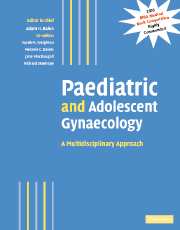Book contents
- Frontmatter
- Contents
- Contributors
- Preface
- Part I Normal development
- Part II Management of developmental abnormalities of the genital tract
- Part III Management of specific disorders
- 18 Disorders of growth and puberty
- 19 Turner's syndrome
- 20 Androgen insensitivity syndromes
- 21 Rokitansky syndrome and other Müllerian anomalies
- 22 The XY female
- 23 The gynaecology of the major genitourinary anomalies
- 24 Congenital adrenal hyperplasia
- 25 Long-term sequelae of genital surgery
- 26 Amenorrhoea
- 27 The polycystic ovary syndrome and adolescent women
- 28 Menstrual disorders in adolescent girls
- 29 Pelvic pain, ovarian cysts and endometriosis in adolescent girls
- 30 Premature ovarian failure and ovarian ageing
- 31 Gynaecological cancers in childhood
- 32 Late reproductive sequelae of treatment for childhood cancer
- 33 Preservation of fertility before cancer therapy
- 34 The management of infertility with surrogacy and egg donation
- 35 Dermatological conditions of the female genitalia
- 36 Vaginal discharge
- 37 Psychological gender development in individuals born with ambiguous genitalia
- 38 Eating disorders in adolescence
- 39 Nutritional amenorrhoea: long-term sequelae
- 40 How to set up a service: how to teach and train
- Index
- Plate section
- References
20 - Androgen insensitivity syndromes
from Part III - Management of specific disorders
Published online by Cambridge University Press: 04 May 2010
- Frontmatter
- Contents
- Contributors
- Preface
- Part I Normal development
- Part II Management of developmental abnormalities of the genital tract
- Part III Management of specific disorders
- 18 Disorders of growth and puberty
- 19 Turner's syndrome
- 20 Androgen insensitivity syndromes
- 21 Rokitansky syndrome and other Müllerian anomalies
- 22 The XY female
- 23 The gynaecology of the major genitourinary anomalies
- 24 Congenital adrenal hyperplasia
- 25 Long-term sequelae of genital surgery
- 26 Amenorrhoea
- 27 The polycystic ovary syndrome and adolescent women
- 28 Menstrual disorders in adolescent girls
- 29 Pelvic pain, ovarian cysts and endometriosis in adolescent girls
- 30 Premature ovarian failure and ovarian ageing
- 31 Gynaecological cancers in childhood
- 32 Late reproductive sequelae of treatment for childhood cancer
- 33 Preservation of fertility before cancer therapy
- 34 The management of infertility with surrogacy and egg donation
- 35 Dermatological conditions of the female genitalia
- 36 Vaginal discharge
- 37 Psychological gender development in individuals born with ambiguous genitalia
- 38 Eating disorders in adolescence
- 39 Nutritional amenorrhoea: long-term sequelae
- 40 How to set up a service: how to teach and train
- Index
- Plate section
- References
Summary
Introduction
Androgen insensitivity syndromes (AIS) arise from target tissue resistance to androgen action. The clinical manifestations of androgen resistance vary from external genitalia that are completely female to degrees of partial masculinization. These syndromes are the most common identifiable cause of male undermasculinization.
Role of androgens in sex determination
After development of the testis (sex determination), which is not androgen dependent, the events of male sex differentiation involve two pathways, one inhibitory and one stimulatory. The principal function of the inhibitory pathway is to cause regression of the Müllerian ducts and thus to repress the development of female internal genitalia (Fallopian tubes, uterus, and upper third of the vagina). This process occurs between six and eight weeks' gestation, mediated by anti-Müllerian hormone (Josso and Clemente, 2003). The stimulatory events of male sex differentiation require high levels of androgens and a functional androgen receptor (AR). Testosterone is thought to be critical in stabilizing the Wolffian duct system to prevent its involution and to induce differentiation into the epididymides, vasa deferentia and seminal vesicles. Stabilization of the Wolffian ducts occurs between 9 and 13 weeks' gestation, when testosterone is secreted from the testes, mostly under the control of placental chorionic gonadotrophin. Dihydrotestosterone (DHT) cannot be involved in this process, as the 5α-reductase enzyme that converts testosterone into DHT is not yet expressed in these tissues (Wilson et al., 1993).
- Type
- Chapter
- Information
- Paediatric and Adolescent GynaecologyA Multidisciplinary Approach, pp. 253 - 266Publisher: Cambridge University PressPrint publication year: 2004
References
- 2
- Cited by

